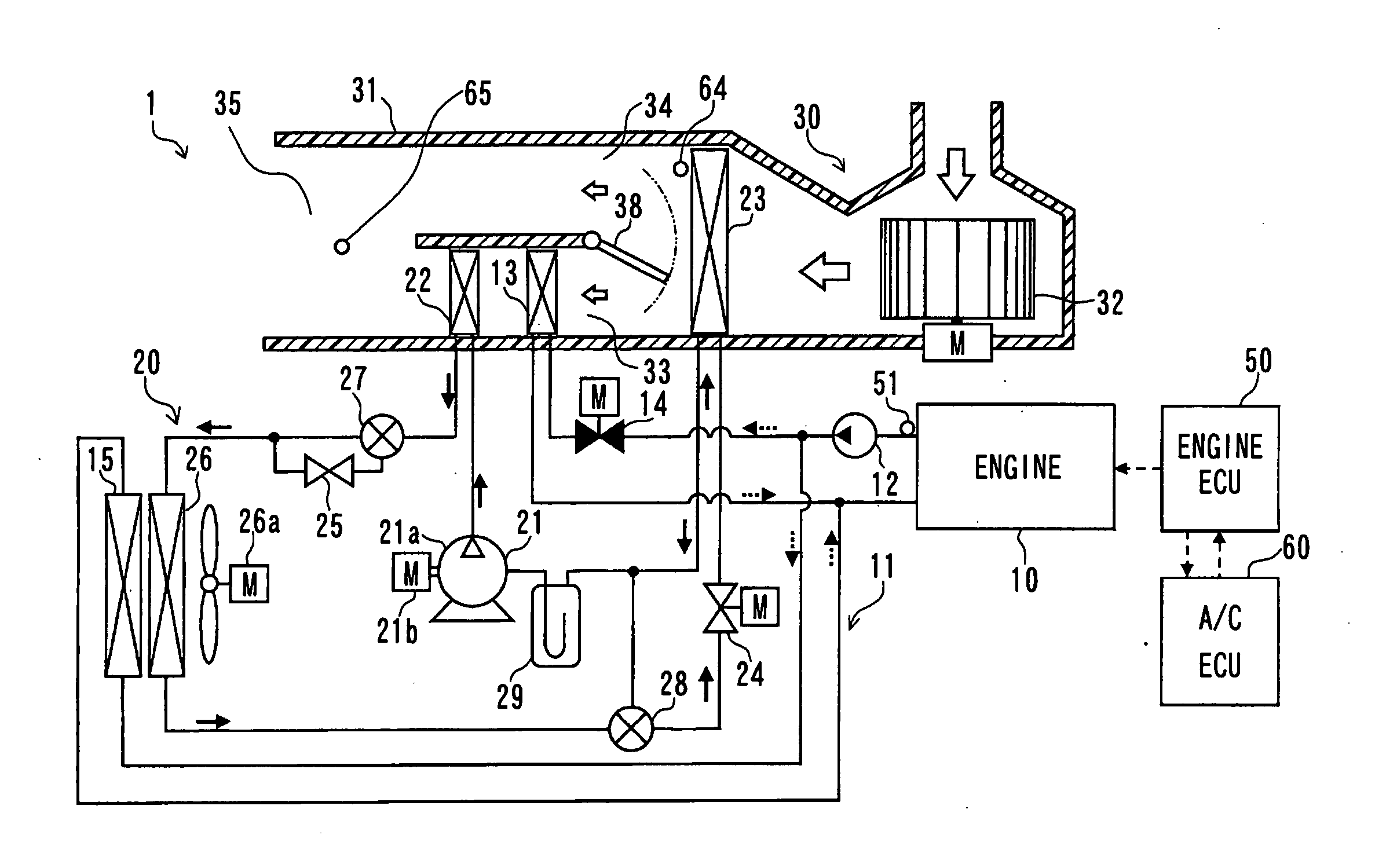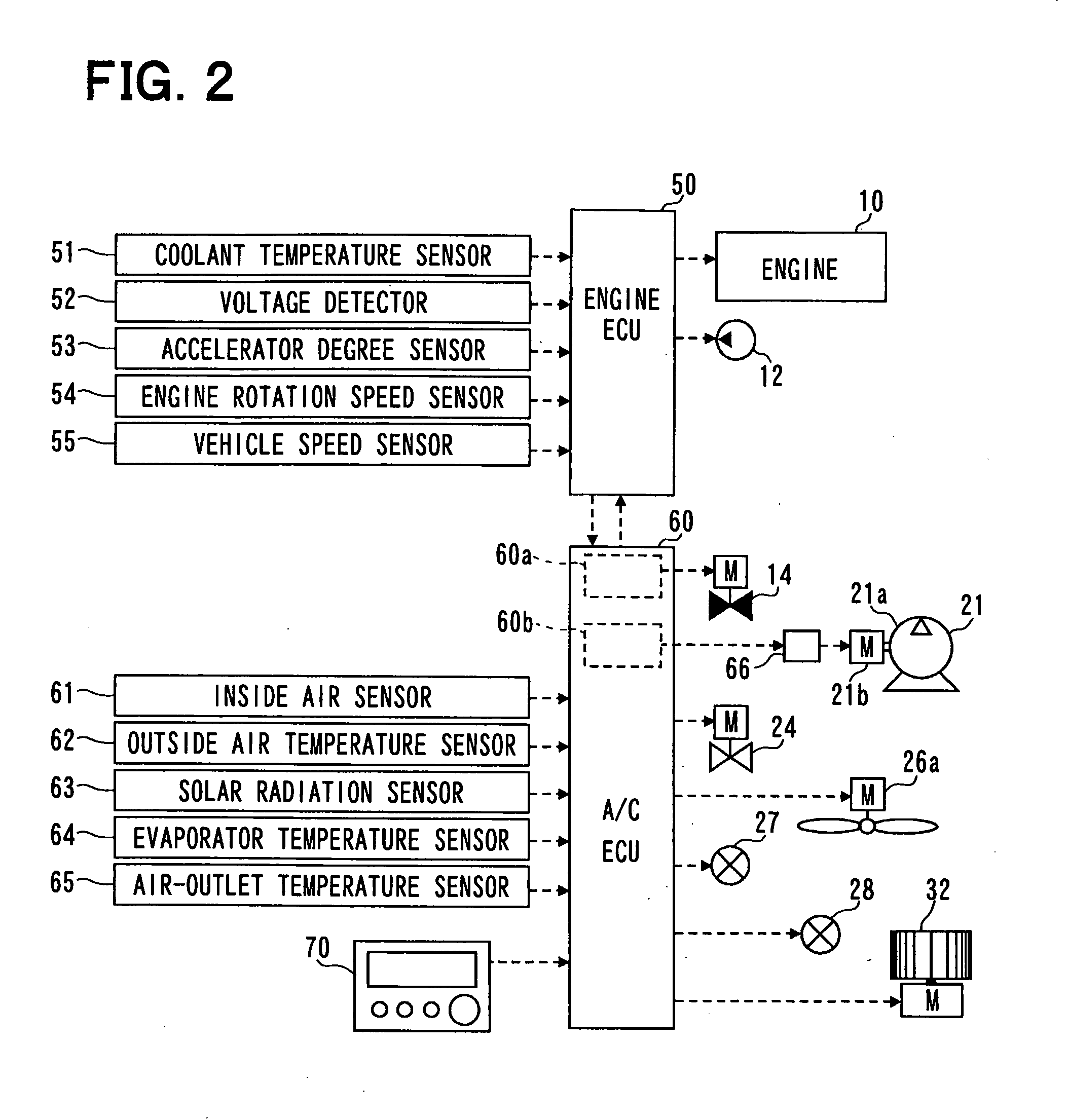Air conditioner for vehicle
a technology for air conditioners and vehicles, applied in vehicle components, vehicle heating/cooling devices, railway heating/cooling, etc., to achieve the effect of restricting the deterioration of the fuel consumption of the vehicl
- Summary
- Abstract
- Description
- Claims
- Application Information
AI Technical Summary
Benefits of technology
Problems solved by technology
Method used
Image
Examples
first embodiment
[0046]A first embodiment of the invention will be described below with reference to FIGS. 1 to 8. FIG. 1 is a schematic diagram showing an air conditioner 1 for a vehicle according to a first embodiment of the invention. In the present embodiment, the air conditioner 1 is typically used for a hybrid vehicle which is traveled by a vehicle driving force composed of an internal combustion engine 10 and an electrical motor for a vehicle traveling.
[0047]In the hybrid vehicle of the embodiment, the engine 10 is operated or stopped in accordance with a traveling load of the vehicle. Thus, the hybrid vehicle can be switched to a traveling state in which the vehicle is traveled by using driving force from both of the engine 10 and the electrical motor for traveling, or a traveling state (i.e., EV traveling state) in which the vehicle is traveled only by using the electrical motor for traveling while the engine is stopped. Thus, in the hybrid vehicle, fuel consumption can be improved as compa...
second embodiment
[0165]A second embodiment of the invention will be described with reference to FIGS. 5 and 10.
[0166]In the above-described first embodiment, the flow adjustment valve 14 is used as an example of the heating capacity changing portion. However, in the second embodiment, the flow adjustment valve 14 is omitted, and a bypass passage 16 and an open degree adjustment valve 17 are used as the heating capacity changing portion. The bypass passage 16 is configured such that the coolant flows through the bypass passage 16 while bypassing the heater core 13. Furthermore, the open degree adjustment valve 17 is configured to adjust an open degree of the bypass passage 16 so as to change the flow amount of the engine coolant flowing through the heater core 13.
[0167]Furthermore, in the present embodiment, at step S11 of FIG. 5, the flow amount Gw of the coolant is determined such that the heating capacity of the heater core 13 is approached to the allowable heating capacity Qw_cap, and the open de...
third embodiment
[0169]A third embodiment of the invention will be described with reference to FIGS. 5 and 11.
[0170]In the above-described first and second embodiments, the heating capacity changing portion is configured to change the flow amount of engine coolant flowing through the heater core 13. However, in the present embodiment, as shown in FIG. 11, the flow amount of air flowing through the heater core 13 is changed so that the heating capacity of the heater core 13 is changed.
[0171]Because the allowable heating capacity Qw_cap is an allowable heat radiation amount of the heater core 13, the allowable heat radiation amount of the heater core 13 is the maximum heat absorbing amount of air in the heater core 13. Thus, by changing the maximum heat absorbing amount of air, the heat radiation amount of the heater core 13, that is, the heating capacity of the heater core 13 can be changed.
[0172]In the present embodiment, a heater-core bypass passage 36 is provided in the first air passage 33, so th...
PUM
 Login to View More
Login to View More Abstract
Description
Claims
Application Information
 Login to View More
Login to View More - R&D
- Intellectual Property
- Life Sciences
- Materials
- Tech Scout
- Unparalleled Data Quality
- Higher Quality Content
- 60% Fewer Hallucinations
Browse by: Latest US Patents, China's latest patents, Technical Efficacy Thesaurus, Application Domain, Technology Topic, Popular Technical Reports.
© 2025 PatSnap. All rights reserved.Legal|Privacy policy|Modern Slavery Act Transparency Statement|Sitemap|About US| Contact US: help@patsnap.com



